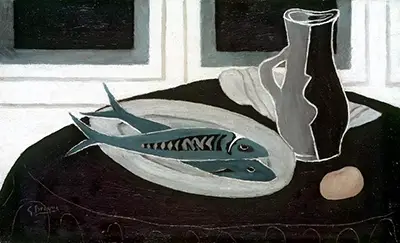This particular piece focuses on two fish and a bottle, and the simplicity of this painting makes it one of his more charming pieces. There is not the busy chaos of other cubist artworks here, but a more relaxed, but modern, depiction of a table top with a lunchtime spread. Culinary themes are so important within French society and so it made sense for this artist to make use of them as inspiration for his work. Additionally, he is known to have appreciated the ability to tweak his scenes by hand prior to commencing his work, an option unavailable in most other genres of work. The style here is clear, with every time being faithfully reproduced in terms of arrangement, without the fractal explosions of his other periods.
Here we find a dark shadow placed on the right hand side of the bottle, a method used by the artist during this period. Rather than blending from one side to the other, the shadow is delivered as a thick layer of colour which could almost be a part of the original design for the bottle. This also underlines how the light is coming in from the left in this painting, and we can also spot two small windows at the back of the scene. Besides the fish which lie patiently on the small bowl, there is also a small cloth and perhaps a fruit or egg alongside. The table is covered in a dark cloth which offers us very little detail, but does provide a stronger contrast for the items that sit on top of it.
An example of the artist's versatility would be Bottle and Fishes, which takes the same content but applies a very different style, giving a completely different result in that case. It is an interesting career for those interested in still life art, with so many different interpretations of the same objects being displayed across his career oeuvre.


